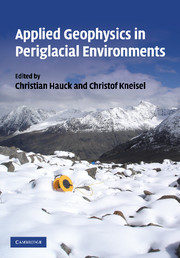Book contents
- Frontmatter
- Contents
- List of contributors
- Introduction
- Part I Geophysical methods
- Part II Case studies
- 5 Typology of vertical electrical soundings for permafrost/ground ice investigation in the forefields of small alpine glaciers
- 6 ERT imaging for frozen ground detection
- 7 Electrical resistivity values of frozen soil from VES and TEM field observations and laboratory experiments
- 8 Results of geophysical surveys on Kasprowy Wierch, the Tatra Mountains, Poland
- 9 Reassessment of DC resistivity in rock glaciers by comparing with P-wave velocity: a case study in the Swiss Alps
- 10 Quantifying the ice content in low-altitude scree slopes using geophysical methods
- 11 The use of GPR in determining talus thickness and talus structure
- 12 GPR soundings of rock glaciers on Svalbard
- 13 Arctic glaciers and ground-penetrating radar. Case study: Stagnation Glacier, Bylot Island, Canada
- 14 Mapping of subglacial topography using GPR for determining subglacial hydraulic conditions
- 15 Snow measurements using GPR: example from Amundsenisen, Svalbard
- 16 Mapping frazil ice conditions in rivers using ground penetrating radar
- Appendix: Tables of geophysical parameters for periglacial environments
- Index
- Plate section
- References
7 - Electrical resistivity values of frozen soil from VES and TEM field observations and laboratory experiments
Published online by Cambridge University Press: 22 August 2009
- Frontmatter
- Contents
- List of contributors
- Introduction
- Part I Geophysical methods
- Part II Case studies
- 5 Typology of vertical electrical soundings for permafrost/ground ice investigation in the forefields of small alpine glaciers
- 6 ERT imaging for frozen ground detection
- 7 Electrical resistivity values of frozen soil from VES and TEM field observations and laboratory experiments
- 8 Results of geophysical surveys on Kasprowy Wierch, the Tatra Mountains, Poland
- 9 Reassessment of DC resistivity in rock glaciers by comparing with P-wave velocity: a case study in the Swiss Alps
- 10 Quantifying the ice content in low-altitude scree slopes using geophysical methods
- 11 The use of GPR in determining talus thickness and talus structure
- 12 GPR soundings of rock glaciers on Svalbard
- 13 Arctic glaciers and ground-penetrating radar. Case study: Stagnation Glacier, Bylot Island, Canada
- 14 Mapping of subglacial topography using GPR for determining subglacial hydraulic conditions
- 15 Snow measurements using GPR: example from Amundsenisen, Svalbard
- 16 Mapping frazil ice conditions in rivers using ground penetrating radar
- Appendix: Tables of geophysical parameters for periglacial environments
- Index
- Plate section
- References
Summary
Introduction
Geophysical approaches have been widely utilised to provide information on permafrost properties or distribution (e.g. Scott et al. 1990). The application of geophysical methods to permafrost regions is based on changes of the physical properties of earth materials associated with the freezing of incorporated water. Among them, electrical resistivity values increase greatly when soil water freezes, and electrical sounding methods continue to be used in a number of permafrost studies, as demonstrated in Chapters 1 and 2 as well as in Case Studies 5–10.
It is well known that the electrical resistivity value of soil depends on soil type, temperature, water content, porosity and salinity. To be able to interpret results from resistivity surveys in periglacial environments, it is important to analyse the characteristics of electrical resistivity of frozen soil. Field observations using geophysical methods have been carried out in order to detect permafrost structure and evaluate its applicability for permafrost mapping since 1992. This chapter introduces some observational results from permafrost areas, including resistivity values and their relation to permafrost. In addition, results from corresponding laboratory experiments are shown.
Methods
The applied geophysical methods are vertical electrical soundings (VES, see Chapter 1) and transient electromagnetic (TEM, see Chapter 2) soundings. A conventional resistivity meter, McOHM model 2115 by OYO Co. Ltd., was used for the VES. The transient data of TEM surveys were recorded using a PROTEM 47 TEM system by Geonics Ltd. with a receiver coil having an effective area of 31.4 m2.
- Type
- Chapter
- Information
- Applied Geophysics in Periglacial Environments , pp. 118 - 125Publisher: Cambridge University PressPrint publication year: 2008
References
- 1
- Cited by



